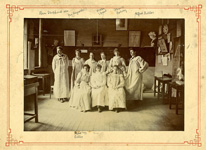
Divisions
-
Community Partnerships and Priorities
- Aboriginal Partnerships
- Aboriginal Heritage Tasmania
- Child and Youth Wellbeing
-
Community Policy and Engagement
- Advisory groups
- Centenary of ANZAC
- Companion Card Program
- Concessions Guide
- Prevention of Family and Sexual Violence
- International Women's Day
- Frank MacDonald Memorial Prize
- Significant Tasmanian women
- Tasmanian Honour Roll of Women
- Women on Tasmanian boards and committees
- Veterans Programs
- Seniors Card
- Tasmanian Carer Action Plan
- Older persons
- LGBTIQA+ Tasmanians
- Volunteering
- Our Multicultural Island
- Food Relief to Food Resilience
- People with Disability
- Women
- Community and Disability Services
- Community Grants
- Contact
- Digital Strategy and Services
- Office of Local Government
- Office of Parliamentary Counsel
- Office of Review and Evaluation
- Office of the Secretary
- Office of Security and Emergency Management
- Corporate and Government Services
- Policy Division
- Service Tasmania Unit
- State Service Management Office
Contact Details
By phone
Find the number of a specific division or office to contact them directly or call Service Tasmania on 1300 135 513.
Our staff
Use the Tasmanian Government Directory to find staff contact details
Social media
Follow our social media accounts to keep up to date with specific programs and initiatives.
Florence Rodway
(1881-1971)
Portrait painter, pastellist and miniaturist
 Hobart Technical Education Art Class 1903 - Florence Rodway standing second from right.
Hobart Technical Education Art Class 1903 - Florence Rodway standing second from right.
(Reproduced courtesy of the Archives Office of Tasmania: Reference No PH30/1/113)
Florence Rodway was born in Hobart on 11 November 1881. She studied painting, modelling and life-drawing at the Hobart Technical College where Mildred Lovett was a fellow student.
In 1902, Florence won a four-year scholarship to the Royal Academy in London. However, in 1906 Florence returned to Sydney, as she could not afford to continue her studies in London. She continued her studies in Julian Ashton’s evening classes. Florence was a foundation member of the Society of Women Painters in 1910 and a member of the Society of Artists from 1908-30.
Florence’s portrait studies received awards in the Society of Artists’ Exhibitions of 1909 and 1910. The Sydney Art Galley purchased two of her portrait studies in 1910, providing a major impetus to her career. Florence was in demand as a portraitist, drawing up to 20 portraits a year, many of them of children.
Recognition of Florence’s expertise as a portraitist provided her with unique opportunities. In 1918 the Trustees of the Art Gallery commissioned a posthumous portrait of General William Bridges – one of only a few commissions awarded to women in this era. Florence’s fee was only a quarter of that paid to male artists undertaking similar commissions. In 1921, Florence was officially commissioned by the Australian War Museum to paint a posthumous portrait of Brigadier General MacLaurin, who had died in action during World War One. She was the only woman to receive such a commission from the War Museum.
J F Archibald, the editor of the Bulletin and founder of the Archibald Prize, was an enthusiastic supporter of Florence’s work during her time in Sydney, recommending her for several commissions. She was subsequently commissioned to paint a posthumous portrait of Archibald for the Trustees of the Art Gallery of New South Wales.
Other commissions included Sir Adrian Knox, George Rignold, Sir William Cullen, Dame Nellie Melba, her father Leonard Rodway (Honorary Government Botanist) for the Royal Society of Tasmania, Julian Ashton, William Charles Wentworth, Henry Lawson and his children.
In 1920 Florence married engineer Walter Moore, and her daughter Susanne was born in 1922. The family returned to Hobart in the early 1930’s and Florence continued to work from a home studio.
In the mid-1930s. Florence shared a studio with other prominent Tasmanian women artists of her era, including Edith Holmes, Mildred Lovett, Dorothy Stonor, Ethel Nicholls and Violet Vimpany, at 76 Collins Street Hobart.
She held two exhibitions with Edith Holmes at the Westminster Gallery, Melbourne, in 1948 and at the Adult Education Board, Hobart, in 1953. Florence exhibited with the Art Society of Tasmania and the Tasmanian Group of Painters, and exhibited extensively in Australia throughout her career.
Florence Rodway died on 23 January 1971 in Hobart.
Sources :
Article by Sue Backhouse Australian Dictionary of Biography Volume II 1891-1939
Catherine Speck, Painting Ghosts – Australian Women Artist in Wartime, Craftsman House 2004.
An example of Florence’s portrait work can be seen on the Archibald Prize website.

